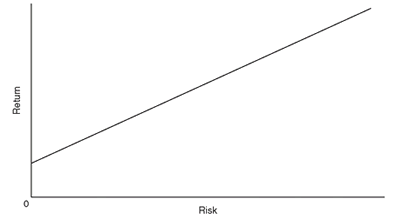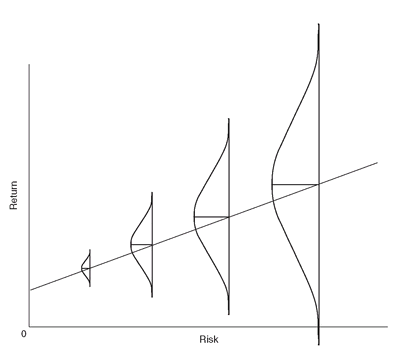 I’m currently reading the book The Most Important Thing: Uncommon Sense for the Thoughtful Investor by Howard Marks. Inside, he talks a lot about risk. Most people seems to grasp the idea that riskier investments offer the prospect of higher returns. Stocks are expected to offer higher returns than cash or bonds. Bonds are considered less risky, and thus return less. However, Marks states that too many people have a simplistic risk/return relationship in their heads:
I’m currently reading the book The Most Important Thing: Uncommon Sense for the Thoughtful Investor by Howard Marks. Inside, he talks a lot about risk. Most people seems to grasp the idea that riskier investments offer the prospect of higher returns. Stocks are expected to offer higher returns than cash or bonds. Bonds are considered less risky, and thus return less. However, Marks states that too many people have a simplistic risk/return relationship in their heads:

Source: Table 5.1, The Most Important Thing
However, there is no requirement that riskier investments will actually provide those higher returns. It’s only the average expected returns that are higher, but since the uncertainty is also higher. Put another way, the distribution of potential returns is wider. To be more precise, he shares this risk/expected return chart instead:

Source: Table 5.2, The Most Important Thing
When I started investing several years ago, I remember reading several personal finance articles that responded to questions from older investors that had some catching up to do with their nest eggs. The solution was simple – own more stocks! You’ll need the extra return, they reasoned. That’s exactly the wrong way to think. There is no easy shortcut to saving more.
 The Best Credit Card Bonus Offers – 2025
The Best Credit Card Bonus Offers – 2025 Big List of Free Stocks from Brokerage Apps
Big List of Free Stocks from Brokerage Apps Best Interest Rates on Cash - 2025
Best Interest Rates on Cash - 2025 Free Credit Scores x 3 + Free Credit Monitoring
Free Credit Scores x 3 + Free Credit Monitoring Best No Fee 0% APR Balance Transfer Offers
Best No Fee 0% APR Balance Transfer Offers Little-Known Cellular Data Plans That Can Save Big Money
Little-Known Cellular Data Plans That Can Save Big Money How To Haggle Your Cable or Direct TV Bill
How To Haggle Your Cable or Direct TV Bill Big List of Free Consumer Data Reports (Credit, Rent, Work)
Big List of Free Consumer Data Reports (Credit, Rent, Work)
I like Howard Marks and have been reading his letters for years. If you added a z-axis to the second figure to represent time, further away from the origin (longer holding periods) those probability distributions should tighten back up again, if we assume that returns are independent or uncorrelated from period to period. However, the line in the first figure (and second) would also pivot down a little bit from the risk-free rate (intersection with the y-axis) because compound returns come down with higher volatility.
The point I’m trying to make is that if you have a longer time horizon you are more likely to achieve the higher expected return associated with riskier assets than in any one period.
“Stocks are expected to offer higher returns than stocks”
I think you meant bonds?
@Victor – Good catch, fixed it.
I agree with Andy. This graph looks pretty accurate for investing for one day, or a very short time period. As you add time to the equation, the bow and arrows should shift up. If you add enough time to the equation, they should shift up so high that even the poorer outlooks do better than bonds. In other words over the next 50 years stocks would have to do incredibly poorly to not outperform bonds.
@David
‘In the long run, we are all dead’ -John Maynard Keynes
Stocks SHOULD outperform over the long-haul vs. bonds, but there are definitely periods of euphoria and depression that alter this equation over the short-term.
I think one of the more honest discussions of this disequilibrium was in ‘A Random Walk Down Wall Street,’ where a fairly staunch classic economist discusses in Part 1 a lot of the historical market crazes, such as the Dutch Tulip craze.
@Johnathan is right about the bad advice given to older investors; overweighting stocks at the near end of your career is very risky and is subject to potential permanent capital loss, which a retiree would be hard-pressed to recover from.
How can investors be successful without research? Risk is definitely part of the game, but risk without knowledge is vital to success.
Your graph is correct comparing risk/returns of bonds vs stocks e.g. But within an asset class it is not — riskier stocks and bonds do not generally generate more return than less risky ones, just more uncertainty.